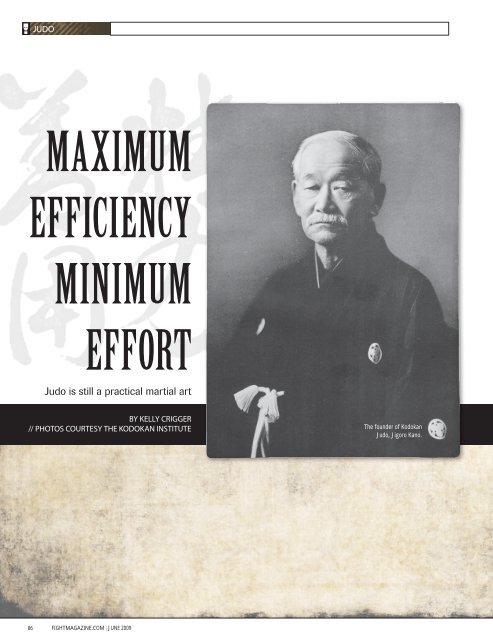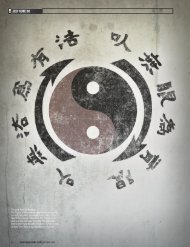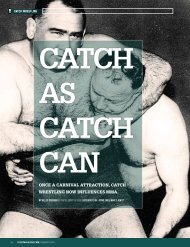MAXIMUM EFFICIENCY MINIMUM EFFORT - Kelly Crigger
MAXIMUM EFFICIENCY MINIMUM EFFORT - Kelly Crigger
MAXIMUM EFFICIENCY MINIMUM EFFORT - Kelly Crigger
You also want an ePaper? Increase the reach of your titles
YUMPU automatically turns print PDFs into web optimized ePapers that Google loves.
JUDO<br />
<strong>MAXIMUM</strong><br />
<strong>EFFICIENCY</strong><br />
<strong>MINIMUM</strong><br />
<strong>EFFORT</strong><br />
Judo is still a practical martial art<br />
by KELLY CRIGGER<br />
// PHOTOS COURTESY THE KODOKAN INSTITUTE<br />
The founder of Kodokan<br />
Judo, Jigoro Kano.<br />
86 FIGHTMAGAZINE.COM | JUNE 2009
JUDO<br />
“Your Jiu-Jitsu is no good here.”<br />
If T-shirts with snappy sayings had been fashionable in 1880, Jigoro<br />
Kano would have stood at the gate of Eishoji temple proudly brandishing<br />
this phrase across his chest. After studying several different styles<br />
of Jiu-Jitsu, Kano took the best parts of each, added his own principles<br />
of throwing and off-balancing, and founded Judo. Within a few years,<br />
he wiped his mats with Jiu-Jitsu pupils and indirectly spawned two<br />
more martial arts that have had a lasting effect on MMA. And that<br />
wasn’t even his day job.<br />
The Kid Can’t Sit Still<br />
A history of Judo is essentially the history of its<br />
founder, Jigoro Kano, and the conditions under which<br />
the art was formed. He was born into a sake-brewing<br />
family during a time of great change in Japan. It was<br />
six years after Admiral Perry’s steamships had entered<br />
Tokyo Bay and proved the futility of the feudal system<br />
to the Japanese people. By the time Kano was eight<br />
years old, his country had endured a revolution that<br />
deposed the ruling Shogunate and reinstated Emperor<br />
Meiji. His formative years were filled with excitement<br />
and a burgeoning curiosity about the world beyond<br />
the seas, which the Shoguns had defiantly guarded<br />
the population against for three centuries. His teenage<br />
years were a tornado of new social and intellectual<br />
changes that fueled his desire to know more—a characteristic<br />
that would define his life.<br />
Despite being a government employee at a time<br />
when the government was crumbling, Kano’s father<br />
wasn’t destitute. He ensured that his kids were well<br />
educated by Neo-Confucian scholars and European<br />
private schools. Thus Jigoro, the youngest of three, wasn’t a stereotypical<br />
street-tough candidate for the title of “pioneer of fighting.”<br />
But bullies are a staple of any society, and since Kano was a<br />
scrawny five-foot-two, and the very definition of a ninety-pound<br />
weakling, he was easy prey. Fortunately, the youngster didn’t take<br />
kindly to playing the role of victim, and he dedicated himself<br />
to learning self-defense despite his father’s protestations (Jiu-Jitsu<br />
was known for developing aggressive youth).<br />
Kano enrolled in college at Tokyo Imperial University, where<br />
he became absorbed in academia. He loved learning and didn’t<br />
limit it to the classroom, especially when it came to the ancient<br />
ways that were dying out so rapidly under a blossoming Japanese<br />
intellectual society that craved everything western. Oddly<br />
enough, Jiu-Jitsu was being maintained at the time by osteopaths<br />
(sometimes called “bonesetters”), so Kano sought out a doctor<br />
who could teach him how to stop getting his ass kicked. Unfortunately,<br />
Kano chose Jiu-Jitsu masters who had a bad habit of dying.<br />
His first instructor, Hachinosuke Fukuda, met an untimely<br />
demise shortly after Kano walked through his door, so you would<br />
think Iso Masatomo would have kept young Kano out. He didn’t,<br />
and died shortly thereafter.<br />
Kano found a new school and discovered that moving around<br />
like an Army brat had its advantages. The constant upheaval from<br />
school to school gave him an opportunity to compare styles and<br />
determine what worked and what didn’t. In the waning days of<br />
the nineteenth century, Jiu-Jitsu was taught in two forms: kata, or<br />
rigid form, and randori, which meant “free form,” similar to what<br />
we would call open mat grappling today. Fukuda’s Tenjin Shinyoryu<br />
style stressed randori over kata, and favored actual practice<br />
over rigid forms. Masatomo’s style stressed free-form grappling as<br />
well, but he was also a master of striking vital areas. Kano’s third<br />
teacher was Iikubo Tsunetoshi, who taught him Kito-ryu Jiu-Jitsu,<br />
as well as the throwing techniques for which Judo would eventually<br />
become renowned. Kano didn’t stop there. When he repeatedly<br />
lost to a larger student in his dojo and needed a way to compensate<br />
for his smaller stature, he added Sumo wrestling moves to<br />
Students of the<br />
Kodokan Judo clan<br />
assemble before<br />
Jigoro Kano.<br />
FIGHTMAGAZINE.COM | JUNE 2009<br />
87
JUDO<br />
his repertoire. It was his open mind and willingness to try whatever<br />
worked that formed the basis of Judo, which was technically<br />
the first mixed martial art. But he wasn’t there just yet.<br />
I Did It My Way<br />
In only four years Kano was licensed to teach Jiu-Jitsu and,<br />
in 1882, at just twenty-two years old, he felt the time had come<br />
to teach on his own. The precocious youth took nine students<br />
and twelve tatami mats to Eishoji Buddhist temple, in Kamakura,<br />
to teach his reformed style of Jiu-Jitsu. Kano focused his teachings<br />
on breaking his opponent’s posture before moving in for<br />
the throw—an unheard-of technique at the time. “The transition<br />
from Jiu-Jitsu to Judo was made slowly but surely,” says author<br />
Andy Adams, “although it is difficult to pinpoint the day when<br />
what that handful of students were learning was no longer Jiu-<br />
Jitsu, but Judo.” Symbolically it was the day he tossed his former<br />
master, Tsunetoshi, around the dojo like a couch pillow during a<br />
randori match.<br />
Two years later, he had his own school, with its own set of bylaws.<br />
Kano would later write, “By taking together all the good<br />
points I had learned of the various schools and adding thereto my<br />
own inventions and discoveries, I devised a new system for physical<br />
culture and moral training. This I call Kodokan Judo.”<br />
Ju means “pliancy” and do means “the way,” which some<br />
have translated as “the gentle way.” Kano’s Judo blended the pinning<br />
and choking techniques of Tenjin Shinyo-ryu Jiu-Jitsu, the<br />
throwing techniques of Kito-ryu, and some Sumo wrestling into<br />
a unique martial art. The revolutionary part of it was kuzushi,<br />
or off-balancing. Judo’s core was to use an opponent’s weight<br />
against him to disrupt his balance and throw him to the ground.<br />
There he would be vulnerable to a pin, choke, or joint lock. Kuzushi<br />
led to an efficiency of effort, and that efficiency led to a<br />
superior technique that enabled a smaller man to defeat a larger<br />
one. Kano found his motto: “The maximum efficiency with min -<br />
imal effort.”<br />
His Judo was taught mostly via randori (free exercise under<br />
contest conditions: throwing, pinning, choking, and joint locks),<br />
although kata (form or prearranged exercises: hitting, kicking,<br />
weapons) was also part of the curriculum. Randori promoted cre -<br />
ativity, free thinking, and free movement. Kata was formulaic,<br />
embodying the Shogun-era view of education as indoctrination,<br />
not the Meiji-era appreciation for discovery. It’s a teaching style,<br />
seen in almost any dojo today, in which an instructor teaches a<br />
move and then allows his students ample time to practice it with<br />
a partner. Judo also embodied the core belief that experience was<br />
more important than strength or power, so an older, wiser judo -<br />
ka (practitioner of Judo) could defeat a stronger, faster student.<br />
But Kano didn’t limit his art to a simple means of self-defense.<br />
He saw in it a way to make people and society better<br />
through the three pillars of Judo: self-defense, physical culture,<br />
and moral behavior. The three were interrelated and inseparable.<br />
“Since the very beginning, I had been categorizing<br />
Judo into three parts,” Kano wrote, “a physical exercise,<br />
a martial art, and the cultivation of wisdom and<br />
virtue. I anticipated that practitioners would develop<br />
their bodies in an ideal manner and also improve their<br />
wisdom and virtue, and make the spirit of Judo live in<br />
their daily lives.”<br />
Chivalry Is Reborn<br />
It’s important to note that Japan in the late nineteenth<br />
century had no concept of sport. It was a society<br />
quickly coming out of three hundred years of isolation<br />
that didn’t understand the meanings of “team” or “fair<br />
play.” Japan was on the other end of the spectrum from<br />
the most powerful nation on the planet—Britain—which<br />
imbued its adolescents with the spirit of competition and<br />
exported its games around the world, including America<br />
(rugby and cricket were the bases for football and baseball).<br />
British youth grew up knowing the meaning of selfless sacrifice,<br />
that the victory of the team is greater than the victory<br />
of the individual. The British saw sport as a part of life that<br />
brought people together peacefully.<br />
Kano believed in the western concept of fair play, and saw the<br />
need for organized sport in everyday life. As the headmaster of the<br />
elite Gakushin School, he mandated that all students participate<br />
in a sport (thus starting the tradition of gym class hazing). Until<br />
that time, the ruling samurai culture believed that the one perfect<br />
cut of a katana blade was all that was needed to end a contest, so<br />
its fighting style was aptly called shobu, or “sudden death.” Kano<br />
saw shobu as stifling creativity because it was risk-averse and detracted<br />
from the student’s ability to formulate a strategy. If a game<br />
had multiple opportunities to score, participants would have to<br />
develop plans of attack and take risks to win, so he organized Judo<br />
contests around point-scoring systems instead of shobu.<br />
1860 – Jigoro Kano<br />
was born.<br />
1871 – Family moved<br />
to Tokyo.<br />
1874 – Sent to private<br />
schools run by Europeans.<br />
1877 – Enrolls at Tokyo<br />
Imperial University.<br />
Starts dabbling in Tenjin<br />
Shinyo-ryu Jiu-Jitsu,<br />
under Hachinosuke<br />
Fukuda.<br />
1879 – Demonstrated<br />
Jiu-Jitsu for Ulysses S.<br />
Grant when he visited<br />
Japan. Fukuda died.<br />
Kano began studying<br />
with Iso Masatomo,<br />
who stressed kata<br />
(form), atemi (striking<br />
vital areas), and randori<br />
(free form).<br />
1881 – Licensed to<br />
teach Tenjin Shinyo-ryu.<br />
Kano saw demo of<br />
Yoshin-ryu by Hirosuke<br />
Totsuka . Masatomo<br />
died. Kato began<br />
training in Kito-ryu<br />
with Iikubo Tsunetoshi<br />
and learned throwing<br />
techniques.<br />
1882 – Became<br />
an instructor at<br />
Gakushuin, an elite<br />
school. Established<br />
Kodokan in a temple;<br />
opened the Kano Juka,<br />
a prep school, and the<br />
Koubunkan, an English<br />
language school.<br />
1883 – Kano established<br />
a dojo at home.<br />
1884 – Judo formally<br />
established, with bylaws.<br />
Red and White<br />
tournament.Rice cake<br />
cutting ceremony.<br />
88 FIGHTMAGAZINE.COM | JUNE 2009
JUDO<br />
1884 was a big year for Judo. Kano had written the first bylaws<br />
of his Kodokan (judo school), instituted the rice cake cutting ceremony<br />
to start his hellish winter training session, and inaugurated<br />
the first Red and White tournament that is now the longest<br />
running competitive sporting event in the world. As Wayne Muromoto<br />
wrote in his magazine, Furyu: The Budo Journal, these early<br />
competitions had rules, but they were still trying to define themselves.<br />
“You scored an ippon (a full point) with throws, chokes,<br />
holds, or arm locks that would, in an actual situation, completely<br />
overwhelm your opponent. You usually went until someone<br />
dropped from sheer exhaustion or the judge ended it, awarding<br />
the match to the clear victor.”<br />
“Kosen students were the green berets of Judo.<br />
They were seen as the cream of the grappling<br />
crop, and their attitude of “I’ll let it snap before I<br />
tap” earned them a great deal of respect”<br />
These achievements, though remarkable, were still known only<br />
among the practitioners of Kodokan Judo. It wasn’t until 1886<br />
that Judo announced its presence with authority to the public by<br />
soundly defeating the powerful Totsuka-ha Yoshin-ryu Jiu-Jitsu<br />
school at a Tokyo Metropolitan Police Academy challenge (final<br />
score 12-2 with two draws, but historical accounts differ ). Suddenly<br />
people took note of the frail Kano and his ability to toss<br />
aside a larger, stronger man effortlessly. The police challenge was<br />
to Judo what the first Stephan Bonnar-Forrest Griffin fight was to<br />
the UFC, and for the next fourteen years, Judo enjoyed a meteoric<br />
rise in popularity.<br />
But at the turn of the century, the art tasted its first bitter pill<br />
of defeat. In 1900, the Kodokan lost a challenge match to the Fusen-ryu<br />
Jiu-Jitsu school, which emphasized newaza, or grappling<br />
techniques, over tachi-waza, or throwing techniques. Kano was<br />
not about to sit around and let his art take a black eye. He sought<br />
out the Fusen-ryu master, Mataemon Tanabe, to learn his repertoire<br />
of grappling techniques, and immediately incorporated<br />
them into the Kodokan’s teachings. This was a milestone because<br />
it started a trend toward grappling Judo, with major ramifications<br />
for the martial arts that can still be seen today.<br />
They Call Me Janus<br />
While Jigoro Kano was obsessive about evolving Judo, it<br />
wasn’t his day job. Kano was first and foremost an educator. In<br />
1901, after nineteen years as the Gakushin School headmaster,<br />
he was appointed as director of the Tokyo Higher Normal School.<br />
Kano made great strides in blending sport into everyday life for his<br />
students, and in 1911 Judo officially became part of the Japanese<br />
school system’s curriculum. His efforts to use sport to foster better<br />
relations were recognized when he was appointed the first Asian<br />
member of the International Olympic Committee. At that time,<br />
the Olympics were not the spectacle of grandeur that they are today<br />
(the 1908 games listed Tug-of-War as a sport), but his appointment<br />
was still another major milestone in the history of Judo.<br />
By 1912, Judo dominated the Japanese martial arts landscape,<br />
and Jiu-Jitsu was in jeopardy of dying out altogether. Kano’s obsession<br />
with learning kicked in and, in order to salvage what he<br />
could from a seemingly doomed art, he pulled together the remaining<br />
authorities on Jiu-Jitsu and adopted their most effective<br />
techniques for the Kodokan. But this had an unforeseen side effect.<br />
Along with a trend toward newaza, which began after the<br />
Fusen-ryu victory, an influx of new ground techniques generated<br />
a highly effective form of grappling Judo, especially at high<br />
school tournaments. It was called Kosen Judo, and the style was<br />
so dominant that, by 1925, Kano’s core tachi-waza throwing<br />
techniques were in danger of becoming extinct.<br />
For the first time in his professional life, Jigoro Kano displayed<br />
a close-minded approach to learning. He changed the rules of<br />
Judo tournaments so that athletes were required to start from a<br />
standing throwing position, so they were forced to learn the core<br />
principles of kuzushi. No matter how close throwing techniques<br />
were to his heart, however, Kano recognized the need for the art<br />
to evolve. Applying a clear double standard, he withdrew his rule<br />
change for a few select schools known as the “Seven Universities.”<br />
To this day, their tournaments are held under different rules from<br />
those of the rest of the Japanese school system ; and it’s in those<br />
tournaments that Kosen Judo still flourishes.<br />
The Judo Virus<br />
Kosen students were the green berets of Judo. They were<br />
seen as the cream of the grappling crop, and their attitude of “I’ll<br />
let it snap before I tap” earned them a great deal of respect in<br />
the sport. It also spawned two Judo offshoots that would become<br />
world renowned: Sambo and Brazilian Jiu-Jitsu.<br />
Mitsuyo Maeda, long credited with having taught the Gracie<br />
family his fighting style, enrolled in the Kodokan in 1897 and was<br />
trained as a judoka during the golden age of grappling Judo. He<br />
proved himself in multiple tournaments, so in 1904 Kano sent<br />
him on a world “Judo is great” tour that eventually ended in Brazil.<br />
Known as the Conde Coma (“Count of Combat”), Maeda reportedly<br />
won over 1,000 matches on four continents as he challenged<br />
anyone and everyone to a fight. His mix of Judo, Jiu-Jitsu,<br />
and striking, which he’d gleaned from so many fights, formed<br />
the nearly perfect street-fighting technique that he taught in his<br />
new school in Brazil during the 1920s. In 1925, Brazilian politician<br />
Gastão Gracie took notice and hired Maeda to teach his sons<br />
Carlos and Helio. If you don’t know the history of Gracie Jiu-Jitsu<br />
thereafter, grab a copy of my book and read chapter two.<br />
Shortly after World War II, one of the greatest milestones in<br />
Judo history occurred in Brazil. Gracie Jiu-Jitsu enjoyed an explosion<br />
in popularity, and the country was captivated with the family’s<br />
resident bad ass, Helio Gracie, who had proven to be a master<br />
1886 – Challenge at<br />
theTokyo Metropolitan<br />
Police Academy.<br />
1888 - Kano gave a<br />
lecture at the British<br />
embassy in Tokyo:<br />
“Gaining Victory by<br />
Yielding to Strength.”<br />
1890 – Second Kodokan<br />
building.<br />
1889 – Kano took first<br />
trip to spread the word<br />
on Judo.<br />
1892 – Kano made first<br />
trip to Shanghai.<br />
1894 – Third Kodokan<br />
building. First Kodokan<br />
council. First special<br />
winter training session<br />
(kangeiko).<br />
1896 – First special<br />
summer training session<br />
(shochugeiko).<br />
1897 – Fourth Kodokan<br />
building.<br />
1898 – Fifth Kodokan<br />
building. Kano was<br />
appointed Director of<br />
Primary Education at<br />
the Ministry of Education.<br />
1901 – Kano appointed<br />
President of Tokyo<br />
Higher Normal School.<br />
1909 – Kano appointed<br />
to IOC. His Kodokan<br />
became a Japanese<br />
foundation<br />
1911 – Judo teachers<br />
training association<br />
established. Judo<br />
introduced as part of<br />
the school system.<br />
FIGHTMAGAZINE.COM | JUNE 2009<br />
89
JUDO<br />
of fighting. In 1949, the Gracies challenged the best in Judo to a<br />
fight in front of 20,000 Brazilians. The result was the epic battle<br />
between Helio and Masahiko Kimura. In eighteen minutes Helio<br />
was overwhelmed, and his elbow was broken when he refused<br />
to tap under the duress of Kimura’s signature move. (If Kimura<br />
had been Tito Ortiz, he would have immediately put on a “Your<br />
Jiu-Jitsu is no good here” tee-shirt). It would be 34 years before<br />
the Gracie family traveled abroad to stage another challenge,<br />
but when they did, it would be big. They called it “The Ultimate<br />
Fighting Championship.”<br />
On the other side of the world, another Kosen Judo student<br />
was taking his own show on the road, though it’s doubtful he<br />
ran into any spicy Brazilian ladies along the way. Vasili Oshchepkov<br />
was awarded his second dan (grades of Judo black belts; there<br />
are five) from Jigoro Kano himself, and he took his art back to<br />
Russia. There he mixed it with various ethnic styles of wrestling<br />
(Georgian, Moldavian , Uzbek, and Armenian) and developed the<br />
framework of what would eventually become the Soviet art of<br />
Sambo. Along with Victor Spiridonov, Oshchepkov taught it to<br />
the Red Army starting in 1923.<br />
During the Cold War, Soviet Sambo had evolved enough to become<br />
a new form that was distinct from traditional Judo. In typical<br />
Soviet fashion, Sambo practitioners thought themselves to be<br />
superior to Judo fighters. That all changed in 1972, when judokas<br />
Katsuhiko Kashiwazaki and Nobuyuki Sato entered a national<br />
Sambo competition in Riga, Latvia, and destroyed everyone. Suddenly,<br />
Sambo clubs converted back into Judo clubs. Those wacky<br />
Soviets had a habit of overestimating themselves.<br />
Mitsuyo Maeda<br />
(AKA Count Coma)<br />
is the man credited<br />
with teaching the<br />
Gracies.<br />
Modern Judo<br />
Back in Japan, Judo had gained nationwide prominence<br />
when the first all-Japan tournament was held in 1930. But just<br />
when it seemed as if Judo would become the national pastime, Japan<br />
entered one of its darkest periods. The 1930s saw the start of<br />
a bloody phase of violent Japanese expansionism that didn’t end<br />
until atomic bombs were dropped on Hiroshima and Nagasaki in<br />
1945. During this time, with most of the country’s fighting-age<br />
men deployed around East Asia, Judo stagnated. It suffered an additional<br />
blow in 1938, when Jigoro Kano died on a ship while en<br />
route back to Japan from an IOC meeting in Cairo.<br />
Under the U.S. occupation after World War II, Japan experienced<br />
a period of nonaggression that reinvigorated the art and<br />
even spread it back to North America. In 1951 the International<br />
Judo Federation was formed and, just five years later, it held its first<br />
World Championships in Tokyo. The IJF opted not to restrict the<br />
competition to weight classes since the philosophy of Judo was<br />
that a smaller man could easily throw a larger one. That theory<br />
was literally tossed out the window at the third world championships,<br />
in 1961, when Dutch judoka Anton Geesink won the world<br />
title. The domination of Judo by a non-Japanese was a shocking<br />
revelation, and it changed the sport. Reluctantly, the IJF instituted<br />
weight classes, but this bad tiding produced good news. The<br />
installment of weight classes meant that the competition was getting<br />
better. Judokas around the world were becoming more and<br />
more skilled at their art, so the division of competitors into classes<br />
based on weight evened out the playing field to compensate for<br />
their prowess. In 1964, Men’s Judo was introduced in the Olympic<br />
Games, and it became a permanent sport in 1972. In 1988, the<br />
open weight class was dropped from Judo Olympic competition,<br />
and in 1992 Women’s Judo became an Olympic sport.<br />
Judo’s influence on Mixed Martial Arts is evident. Several judokas<br />
are successful in MMA, including Pride FC and UFC vet<br />
Rameau Thierry Sokoudjou, who won the US Open Judo championship<br />
in 2001. One of the greatest fighters of all time, Fedor<br />
Emelianenko, comes from a Sambo fighting background. And in<br />
a moment of history repeating itself, Renzo Gracie refused to tap<br />
when caught in a Kimura lock by Kazushi Sakuraba at Pride 10,<br />
resulting in a badly broken elbow.<br />
“Judo almost gives you an unfair advantage in a fight,” says<br />
UFC welterweight Karo Parisyan. “If a guy comes at me like a<br />
beast or tries to get my back, I just use his strength and aggression<br />
against him and dump him on his head.”<br />
Karo needs to wear a printed t-shirt after a win:<br />
“Your Jiu-Jitsu is no good here.”<br />
1920 – Kano left Tokyo<br />
Higher Normal School.<br />
1930 – First All-Japan<br />
Judo tournament.<br />
1938 – Kano died.<br />
1949 – Helio Gracie vs.<br />
Masahiko Kimura fight.<br />
1951 – IJF formed.<br />
1956 – World Judo<br />
Championships in<br />
Tokyo.<br />
1958 – New Kodokan<br />
built.<br />
1961 – Anton Geesink<br />
of Holland won the<br />
world championship.<br />
Weight classes<br />
instituted.<br />
1964 – Men’s Judo<br />
introduced to Olympic<br />
Games.<br />
1972 – Judo became<br />
permanent sport in the<br />
Olympics. Japanese<br />
judokas went to the<br />
Soviet Union and kicked<br />
their asses.<br />
1988 – Open weight<br />
class dropped from<br />
Judo Olympic competition.<br />
1992 – Women’s Judo<br />
became an Olympic<br />
sport.<br />
90 FIGHTMAGAZINE.COM | JUNE 2009







